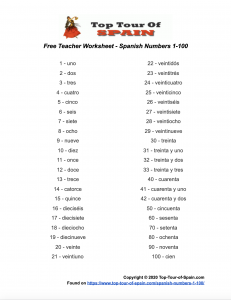On this page, you’ll discover the Spanish numbers up to one hundred clearly explained, plus information about how to use the number one in Spanish.
Whether you are counting money, understanding how much something costs, telling someone how old you are, or saying your lucky number at the roulette table, numbers in Spanish are important! On this page, we’ll cover all numbers from 1-100 so that you can become an expert. We also have a helpful worksheet below if you want to print that out.
Let’s get going on those Spanish numbers up to 100 …
Spanish Numbers 1-100: The Number One
The number for one in Spanish is uno. It loses its o and becomes un when used before a masculine noun.
When used before a feminine noun it changes to una.
For example:
- un niño ….. one boy
- una niña ….. one girl
You should use uno when counting generically, as in:
- one, two, three, four, etc
- uno, dos, tres, cuatro, etc
You should use un or una when counting specifically, as in:
- one banana, one apple, etc
- un plátano, una manzana, etc
So, having explained the various forms of one in Spanish and when to use them, let´s now get started on the list of 1 100 Numbers In Spanish.
Spanish Numbers 1-100: Cardinals 1-10
- 1 : uno
- 2 : dos
- 3 : tres
- 4 : cuatro
- 5 : cinco
- 6 : seis
- 7 : siete
- 8 : ocho
- 9 : nueve
- 10: diez
Spanish Numbers 1-100: Cardinals 11-20
- 11 : once
- 12 : doce
- 13 : trece
- 14 : catorce
- 15 : quince
- 16 : dieciséis
- 17 : diecisiete
- 18 : dieciocho
- 19 : diecinueve
- 20 : veinte
Spanish numbers 16 through to 19 are actually contractions.
For example, the Spanish for 16 – dieciséis – literally means ten and six, but is joined together, as shown below:
- dieciséis = diez y seis
- diecisiete = diez y siete
- dieciocho = diez y ocho
- diecinueve = diez y nueve
Spanish Numbers 1-100: Cardinals 21-30
- 21 : veintiuno
- 22 : veintidós
- 23 : veintitrés
- 24 : veinticuatro
- 25 : veinticinco
- 26 : veintiséis
- 27 : veintisiete
- 28 : veintiocho
- 29 : veintinueve
- 30 : treinta
You’ll notice that, as with the cardinal numbers 16 to 19, the Spanish numbers 21 to 29 are also contractions, but this time of the Spanish for twenty and one, etc.
- veintiuno = veinte y uno
- veintidós = veinte y dos, etc
Spanish Numbers 1-100: Cardinals 40-90
Let’s now look at the Spanish numbers, going up in tens, from 40 to 90.
- 40 : cuarenta
- 50 : cincuenta
- 60 : sesenta
- 70 : setenta
- 80 : ochenta
- 90 : noventa
With these, you just have to add … y uno, … y dos, … y tres onto them and they’re not usually done as contractions. For example:
- 41 : cuarenta y uno
- 42 : cuarenta y dos
- 43 : cuarenta y tres
- 44 : cuarenta y cuatro
- 45 : cuarenta y cinco, etc
This pattern coninues all the way up to 99, which brings us up to our final number for this page – one hundred!
Spanish Numbers 1-100: The Number 100
The Spanish number for one hundred is cien and sometimes ciento.
When there is exactly one hundred of something and the number is used with the noun – be it masculine or feminine – use the shortened form cien. For example:
- cien euros (100 euros)
- cien libras (100 pounds)
Complete List of Numbers 1-100 in Spanish
It isn’t too hard to learn Spanish numbers. Although there are some special rules (ie, irregulars like doce, trece… treinta y dós vs. veintidós), with a little bit of practice, any student can pick it up quickly.
Here is the complete list of numbers 1-100:
- 1 – uno
- 2 – dos
- 3 – tres
- 4 – cuatro
- 5 – cinco
- 6 – seis
- 7 – siete
- 8 – ocho
- 9 – nueve
- 10 – diez
- 11 – once
- 12 – doce
- 13 – trece
- 14 – catorce
- 15 – quince
- 16 – dieciséis
- 17 – diecisiete
- 18 – dieciocho
- 19 – diecinueve
- 20 – veinte
- 21 – veintiuno
- 22 – veintidós
- 23 – veintitrés
- 24 – veinticuatro
- 25 – veinticinco
- 26 – veintiséis
- 27 – veintisiete
- 28 – veintiocho
- 29 – veintinueve
- 30 – treinta
- 31 – treinta y uno
- 32 – treinta y dos
- 33 – treinta y tres
- 40 – cuarenta
- 41 – cuarenta y uno
- 42 – cuarenta y dos
- 50 – cincuenta
- 60 – sesenta
- 70 – setenta
- 80 – ochenta
- 90 – noventa
- 100 – cien
History of Numbers in Spanish
For centuries, Spanish people used the Roman numerical system to communicate numbers. All of this changed when in the 8th century, a man named Leonardo de Pisa brought the Indo-Arabic numerical system to Europe. This numerical system is sometimes called Hindu-Arabic.
Regarding Spain’s use of this new system, we know it was in use there as early as 976 AD! By 1500 AD, this number system had taken Spain by storm; we can see its use spread across Spanish accounting, mathematics, and more.
As European powers began expanding, they brought this modern numerical system abroad – to places like Latin America, Australia, and more. Indeed, this system of numbers is still popular today, as it forms the foundation of science and universal mathematics.
There is one odd difference between Spanish numbers systems and Anglo number systems. In the Spanish language, a “billón” = one million millions, while in Anglo languages, a “billion” = one thousand millions.
Make sense?
Top-Tour-of-Spain Spanish Numbers Worksheet
If you want to put pen to paper, check out our Top-Tour-of-Spain worksheet here:
Print here:
Additional Resources for Learning Numbers in Spanish
Our Learn Spanish Kindle books are terrific value for money!
- Conquer 3535 Spanish Words Instantly is a novel way to quickly learn Spanish vocabulary and grammar, and includes downloadable mp3s to aid pronunciation, plus downloadable Spanish flash cards. If you’re outside the United States, just search for the code B00ITYTFMS at your local Amazon Kindle Store.
- Conquer 918 Spanish Verbs is a simple, 7-Step System for getting to grips with those pesky Spanish Verbs, and also includes downloadable Spanish flash cards. Code number B00EAM4HJO.
Enjoy!
Other Pages of Interest
We have plenty of additional resources on our website for learning Spanish, whether it’s numbers, words, cuisine, or something else! If you’re interested, please check out some of our other articles.
Once you’ve learned counting in Spanish up to 100, check out the page which deals with Spanish numbers over 100.


